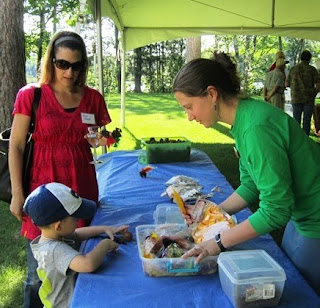By Licia Johnson, Naturalist
We saw our first Monarch butterfly here at the Discovery
Center on May 31st. Almost
every day since then, we have been checking the milkweed (the only host plant
of the Monarch larva) in search of eggs and caterpillars. The flowers on the plants are starting to
bloom and we have yet to find a single egg or caterpillar. In summers past, at this point we usually
have no fewer than 50 Monarchs being reared in our Nature Nook. This year we have some pretty lonely
milkweed. I’ve talked with other
naturalists around the state and they are seeing the same trend.
So where are all the
Monarchs?
We have seen fewer butterflies this
year than any other. Sadly we are not
alone, all states surrounding Wisconsin are also reporting low numbers of
butterflies. As a monarch enthusiast,
the lack of all stages of Monarchs has me greatly concerned. Looking into it a bit more, there are several
factors at play in explaining these low numbers:
· The overwintering population of Monarchs in
Mexico in 2012-2013 was at an all-time low- only 1.19 hectares. This number of butterflies defines the
upper-most limit of butterflies that will be returning north to southern US in
the spring.
· Our hot, dry summers. Locations in a drought, having hot, dry
weather, tend to shorten the lifespan of the adult Monarch butterfly. In turn, they produce less eggs, and thus, less
butterflies.
· Deforestation of the Oyamel fir forests-the only
forests Monarchs travel to in the winter time down in Mexico. The loss of over-wintering habitat is a very
important factor, including many of our neo-migratory birds.
· Changing in crops and farm practices. Many of the milkweed plants that used to grow
in fields are being eliminated.
· Landscaping that contains nonnative species.
· Use of pesticides. This kills larvae and adult caterpillars,
along with the intended insect target.
· Loss of habitat.
As roadsides are mowed down, fields of milkweeds cleared for
development, the amount of habitat for these animals is quickly
diminishing.
What Can You Do?
There are some factors at play here that are hard for us to
interject and correct, but there are many things you can do to help our Monarch
friends (and easy too!):
·
Plant
milkweed in gardens and around your house- they have a
beautiful flower that smells just like lilacs!
·
Encourage others
to plant milkweed.
·
Plant native
flowers as food sources for all butterflies.
·
Don’t use pesticides
or herbicides in gardens and areas where butterflies are found.
·
Rear monarch larvae into the adult stage and
become part of a monitoring effort
that tags them in the fall to contribute to important migration and population
information.
Please feel free to contact me, Licia Johnson licia@discoverycenter.net if you
have any questions about our Monarch population and how you can help them. Monarch
conservation and habitat restoration will be key in the coming years to ensure
a healthy population of Monarch butterflies.
 |
|
The milkweed patch at the
Discovery Center, minus the monarchs!
|
 |
|
Not completely devoid of life, a red milkweed beetle is
often found living amongst the flowers of the milkweed plant.
|
 |
|
The beautiful and fragrant flower of the milkweed is now in
bloom.
|
Sources:
Photos: Licia J.
Where have the butterflies gone? Written by Kristen Jordan Shamus, Detroit
Free Press, July 6, 2013.






